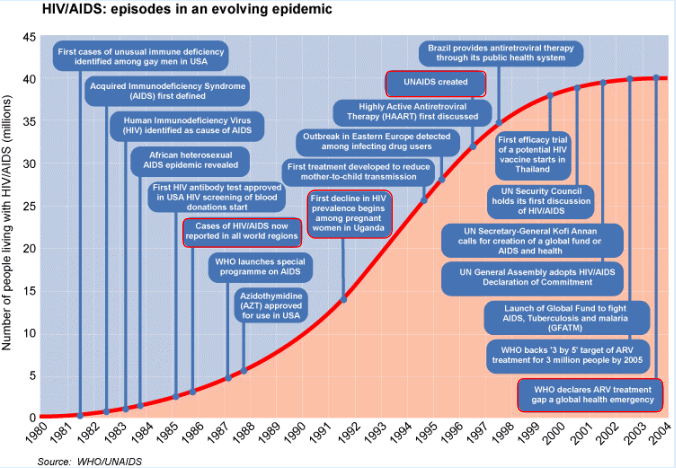
The graph above traces the development of the HIV/AIDS pandemic. Click on the labels with the red border to get more information.
The growth seems to follow the classic epidemic curve: slow growth at first, reaching 5 million by 1987. However, this was 15 million by about 1990. There was then continuous rapid growth in the 1990s and into the 21 st century.
The number of recorded cases between 1998 and 2003 then seems to moderately slow down and plateau. However, the prospects globally into the 21st century are for further increases in Asia, especially in India and China. Because of this, the classic epidemic curve which would suggest a drop off in the number of cases does not seem to be imminent.
This global curve also hides the differences between different countries. These differences are both in terms of prevalence (how many people have the disease) and mortality (how quickly people die from the disease).
Differences between developed and developing countries
In developed countries, the patterns of spread have been very different to developing countries. The differences are partly due to the much lower overall prevalence, the epidemic being more clearly restricted to members of vulnerable groups.
Also important is the very different patterns of mobility of these groups. They tend to live in large urban centres rather small towns or rural areas, and to travel by train or by air between major cities. The diffusion pattern had been shown to be strongly hierarchical in the USA, focussed on the major cities, with San Francisco and New York as the prime foci for the diffusion.
Eastern Europe and Russia
The prevalence of HIV/AIDS is growing rapidly in Eastern Europe and Russia. In fact the greatest rises at the present time are in Eastern Europe and Russia.
Here the main cause is the high growth of intravenous drug use with shared needles in relatively unsanitary conditions of growing poverty and declining health services. These increases are also partly associated with a steep rise in tuberculosis in these regions.
Asia
It seems that the biggest threat from the growth of HIV/AIDS in the future is likely to be in Asia.
Overall levels of HIV/AIDS at the moment are much lower in all countries in Asia than in Africa, however they are growing rapidly.
Thailand, has the highest prevalence in Asia (2%), however Thailand has had a successful public campaign for safe sex and condom use that seems to have kept the epidemic under control.
India has the largest number of infected persons of any country in the world, though this is only just over 1% of adults, and it is here where there are major concerns for further growth.
There are also concerns about the growth of the prevalence of HIV/AIDS in China. There is much less public awareness and discussion of the possible growth of the problem in China.
In these two giants (India and China), there is a potential for rapid further growth, but it is thought unlikely to reach African levels.